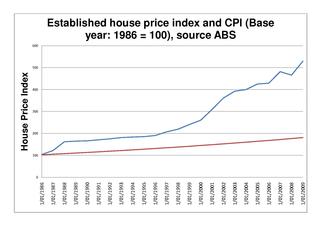Related Research Articles
Inclusionary zoning (IZ), also known as inclusionary housing, refers to municipal and county planning ordinances that require a given share of new construction to be affordable by people with low to moderate incomes. The term inclusionary zoning indicates that these ordinances seek to counter exclusionary zoning practices, which aim to exclude low-cost housing from a municipality through the zoning code. There are variations among different inclusionary zoning programs. Firstly, they can be mandatory or voluntary. Though voluntary programs exist, the great majority has been built as a result of local mandatory programmes requiring developers to include the affordable units in their developments. There are also variations among the set-aside requirements, affordability levels coupled with the period of control. In order to encourage engagements in these zoning programs, developers are awarded with incentives for engaging in these programs, such as density bonus, expedited approval and fee waivers.

Canada Mortgage and Housing Corporation (CMHC) (SCHL) is Canada's national housing agency, and state-owned mortgage insurer. It was originally established after World War II, to help returning war veterans find housing, and is a wholly-owned Crown Corporation of the Government of Canada. Since then, it has seen its mandate expand to the mandate of improving access to housing, including owned and rental.
The affordability of housing in the UK reflects the ability to rent or buy property. There are various ways to determine or estimate housing affordability. One commonly used metric is the median housing affordability ratio; this compares the median price paid for residential property to the median gross annual earnings for full-time workers. According to official government statistics, housing affordability worsened between 2020 and 2021, and since 1997 housing affordability has worsened overall, especially in London. The most affordable local authorities in 2021 were in the North West, Wales, Yorkshire and The Humber, West Midlands and North East.
Subsidized housing is government sponsored economic assistance aimed towards alleviating housing costs and expenses for impoverished people with low to moderate incomes. In the United States, subsidized housing is often called "affordable housing". Forms of subsidies include direct housing subsidies, non-profit housing, public housing, rent supplements/vouchers, and some forms of co-operative and private sector housing. According to some sources, increasing access to housing may contribute to lower poverty rates.
A housing bubble is one of several types of asset price bubbles which periodically occur in the market. The basic concept of a housing bubble is the same as for other asset bubbles, consisting of two main phases. First there is a period where house prices increase dramatically, driven more and more by speculation. In the second phase, house prices fall dramatically. Housing bubbles tend to be among the asset bubbles with the largest effect on the real economy, because they are credit-fueled, because a large number of households participate and not just investors, and because the wealth effect from housing tends to be larger than for other types of financial assets.
A real-estate bubble or property bubble is a type of economic bubble that occurs periodically in local or global real estate markets, and it typically follows a land boom. A land boom is a rapid increase in the market price of real property such as housing until they reach unsustainable levels and then declines. This period, during the run-up to the crash, is also known as froth. The questions of whether real estate bubbles can be identified and prevented, and whether they have broader macroeconomic significance, are answered differently by schools of economic thought, as detailed below.

Public housing in Hong Kong is a set of mass housing programmes through which the Government of Hong Kong provides affordable housing for lower-income residents. It is a major component of housing in Hong Kong, with nearly half of the population now residing in some form of public housing. The public housing policy dates to 1954, after a fire in Shek Kip Mei destroyed thousands of shanty homes and prompted the government to begin constructing homes for the poor.

Affordable housing is housing which is deemed affordable to those with a household income at or below the median as rated by the national government or a local government by a recognized housing affordability index. Most of the literature on affordable housing refers to mortgages and a number of forms that exist along a continuum – from emergency homeless shelters, to transitional housing, to non-market rental, to formal and informal rental, indigenous housing, and ending with affordable home ownership.
Workforce housing is a term that is increasingly used by planners, government, and organizations concerned with housing policy or advocacy. It is gaining cachet with realtors, developers and lenders. Workforce housing can refer to any form of housing, including ownership of single or multi-family homes, as well as occupation of rental units. Workforce housing is generally understood to mean affordable housing for households with earned income that is insufficient to secure quality housing in reasonable proximity to the workplace.

The Australian property market comprises the trade of land and its permanent fixtures located within Australia. The average Australian property price grew 0.5% per year from 1890 to 1990 after inflation, however rose from 1990 to 2017 at a faster rate and may be showing signs of a contracting economic bubble. House prices in Australia receive considerable attention from the media and the Reserve Bank and some commentators have argued that there is an Australian property bubble.

The Australian property bubble is the economic theory that the Australian property market has become or is becoming significantly overpriced and due for a significant downturn. Since the early 2010s, various commentators, including one Treasury official, have claimed the Australian property market is in a significant bubble.

The 2005 Chinese property bubble was a real estate bubble in residential and commercial real estate in China. The New York Times reported that the bubble started to deflate in 2011, while observing increased complaints that members of the middle-class were unable to afford homes in large cities. The deflation of the property bubble is seen as one of the primary causes for China's declining economic growth in 2013.

Housing inequality is a disparity in the quality of housing in a society which is a form of economic inequality. The right to housing is recognized by many national constitutions, and the lack of adequate housing can have adverse consequences for an individual or a family. The term may apply regionally, temporally or culturally. Housing inequality is directly related to racial, social, income and wealth inequality. It is often the result of market forces, discrimination and segregation.
Non-profit housing developers build affordable housing for individuals under-served by the private market. The non-profit housing sector is composed of community development corporations (CDC) and national and regional non-profit housing organizations whose mission is to provide for the needy, the elderly, working households, and others that the private housing market does not adequately serve. Of the total 4.6 million units in the social housing sector, non-profit developers have produced approximately 1.547 million units, or roughly one-third of the total stock. Since non-profit developers seldom have the financial resources or access to capital that for-profit entities do, they often use multiple layers of financing, usually from a variety of sources for both development and operation of these affordable housing units.
The continuum of affordable housing in Canada includes market, non-market, and government-subsidized housing.

The Median multiple or Median house price to income ratio is a housing indicator used to indicate the affordability of housing in any given community. The Median house price to income ratio WAS the primary indicator H1 of the 1991 World Bank/UNCHS Housing Indicator system. It was subsequently used as a measure of affordability by the UN Commission for Sustainable Development, the National Association of Realtors, State of the Environment 2003 Tasmania; and the Mortgage Guide UK along with many other organisations.
The property bubble in New Zealand is a major national economic and social issue. Since the early 1990s, house prices in New Zealand have risen considerably faster than incomes, putting increasing pressure on public housing providers as fewer households have access to housing on the private market. The property bubble has produced significant impacts on inequality in New Zealand, which now has one of the highest homelessness rate in the OECD and a record-high waiting list for public housing. Government policies have attempted to address the crisis since 2013, but have produced limited impacts to reduce prices or increase the supply of affordable housing. However, prices started falling in 2022 in response to tightening of mortgage availability and supply increasing. Some areas saw drops as high as around 9% - albeit from very high prices.

Affordable housing is housing that is deemed affordable to those with a median household income as rated by the national government or a local government by a recognized housing affordability index. A general rule is no more than 30% of gross monthly income should be spent on housing, to be considered affordable for the challenges of promoting affordable housing varies by location.

Joe Flood is a policy, data analyst and mathematician. He has made contributions to mathematics, housing and urban economics, urban indicators, slum studies, climate change and genetic genealogy at every layer of Australian government.
Judith Nancy Yates was an Australian housing economist. She was a lecturer and associate professor at the University of Sydney from 1971 to 2009. As a social liberal economist, she published over 120 papers in academic journals and government and industry reports on most aspects of Australia's housing sector, most notably on distributional aspects of the tax and finance system, on affordability and the supply of low-rent housing.Throughout her career she was appointed to a number of government advisory committees, and she contributed to many government inquiries.
References
- ↑ Malpezzi, Stephen (2000). The contributions of Stephen K. Mayo to housing and urban economics. University of Wisconsin Madison.
- ↑ United Nations High Commissioner for Refugees. "Global Strategy for Shelter to the Year 2000 : resolution adopted by the General Assembly". Refworld. Retrieved 2022-05-09.
- ↑ Mayo, Stephen; Angel, Shlomo (1993). Housing: Enabling Markets to Work. World Bank. doi:10.1596/0-8213-2434-9. ISBN 978-0-8213-2434-9.
- ↑ "Shlomo Angel". Lincoln Institute of Land Policy. Retrieved 2022-05-09.
- ↑ UNCHS/World Bank (1992). The Housing Indicators Program Extensive Survey preliminary results. World Bank,
- ↑ Angel, Shlomo (2004). Housing Policy Matters: A Global Analysis. Oxford University Press. ISBN 978-0195137156.
- 1 2 3 Flood, Joe (1997). "Urban and housing indicators". Urban Studies. 34 (10): 1665–67. doi:10.1080/0042098975385. S2CID 153893995.
- ↑ Hegedus, Josef; Tosics, Ivan (1993). "Housing indicators in transitional economies: A new tool for policy making. The Hungarian housing indicators program intensive survey". Netherlands Journal of Housing and the Built Environment. 8: 85–94. doi:10.1007/BF02503151. S2CID 151262796.
- ↑ Padco Inc and PLAN Inc (1994). "Zimbabwe private sector housing program monitoring and evaluation system: baseline survey and findings" (PDF). USAID. Retrieved 9 May 2022.
- ↑ World Bank/UNCHS (1994). The Housing Indicators Program Vol IV: The Extensive Survey Instrument. Washington D.C.: World bank.
- 1 2 Flood, Joe (9 October 2012). "Housing indicators". International Encyclopedia of Housing and Home. Elsevier. pp. 502–508. ISBN 978-0-08-047171-6.
- ↑ UN-Habitat (2001). Cities in a Globalizing World: Global Report on Human Settlements. Earthscan Publications. pp. 45–46. ISBN 978-1-85383-806-4.
- ↑ "Global housing indicators: evidence for action" (PDF). Habitat for Humanity. 2008.
- ↑ Clapham, David (1992). "Performance assessment and accountability in British housing management". Policy and Politics. 20: 63–74. doi:10.1332/030557392782454123.
- ↑ "Land and Housing Supply Indicators". Australian Bureau of Statistics. 2022-02-16. Retrieved 2022-05-09.
- ↑ "Housing Data Dashboard". Australian Institute of Health and Welfare. Retrieved 2022-05-09.
- ↑ "Affordable Housing Database". OECD. Retrieved 2022-05-09.